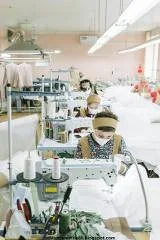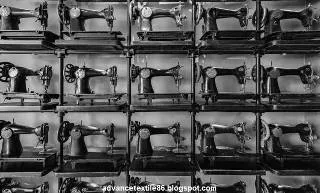Sewing machine
A sewing machine is a machine that is used to sew fabric and materials together
with thread or yarn. It was developed during the first industrial revolution to
reduce the amount of manual sewing work in garment companies. Since the invention
of the first effective sewing machine, commonly regarded as the work of Elias
Howe and the Englishman Thomas St. in 1790, the sewing machine has greatly
developed the efficiency and productivity of the garment industry.
In
a modern sewing machine, the sewing process is done automatically so that the
fabric can easily move in and out of the machine without the hassle of needles,
thimbles, and other tools used in hand sewing. Early sewing machines were
operated either by turning a handle regularly or by a foot-driven treadle
mechanism. Electric-powered machines were introduced later.
History of sewing machine
In
1829, the first practical and widely used sewing machine was invented by a
French tailor, Barthelemy Thimonnier. His machine sewed straight stitches like
Saint's model, and in 1830 he signed a contract with mining engineer August
Ferrand, who made the necessary drawings and submitted a patent
application. His machine was patented on July 17, 1830, and in the same year,
he opened with the partners of the world's first machine-based garment
manufacturing company to make military uniforms for the French army. However,
after the patent was issued, the workers reportedly burned down the factory for
fear for their livelihood.
A
model of the machine is on display at the Science Museum in London. The machine
uses a needle made of wood and cut which creates a loop to hold the thread
through the bottom with the cloth and to lock it by the next loop to pull it.
In 1832, Walter Hunt has invented the first American lockstitch sewing machine.
His instrument used a needle with the eye and the thread-carrying point at the
top of the same end, and a shuttle carrying the thread at the bottom. The
curved needle was moved horizontally through the fabric, retracting the loop.
The shuttle connects the thread and goes through the loop. The feed was
incredible, the machine often had to be shut down and reset. Hunt finally lost
interest in his machine and sold the individual machine without the hassle of
patenting his invention, which was patented until late 1854. John Greenough
patented the first sewing machine in the United States, in 1842. In 1841,
British partners Newton and Archibald introduced the use of eye-pointing
needles and two pressing surfaces to hold pieces of fabric in place.
The first machine to combine all the inequality materials of the previous half-century of innovation in modern sewing machines was the device developed
by the English inventor, John Fisher shortly before the similar machine created
by Isaac Merritt Singer in 1844, and the lesser-known Elias Howe, in 1845.
However, due to Fisher's patent submission to the patent office, he did not
receive proper recognition for the modern sewing machine in a legal dispute of
preference with Singer, and Singer re-took the step.
The singer was seen repairing a rotary sewing machine at a Boston store. As an
engineer, he thought it was inexperienced and decided to make a better design.
The machine he built used a falling shuttle instead of a rotary; the needle was
mounted vertically and included a pressure foot to hold the cloth in place. It
was a fixed arm to hold the needle and included a basic tension system. This
machine combines the components of the machines of Thimonnier, Hunt, and
Howe's. The singer was granted an American patent in 1851.
Meanwhile,
Allen B. Wilson built a shuttle that retracted through a low pressure, which
was an improvement over Singer and Howe's. But John Bradshaw also patented a
similar device and threatened to sue, so Wilson decided to try a new technique.
He partnered with Nathaniel Wheeler to build a machine with rotary hooks
instead of shuttles. It was much quieter and smoother than other techniques,
resulting in the Wheeler & Wilson Company manufacturing more machines in the
1850s and 1860s than any other sewing machine manufacturer. Wilson also
invented the four-motion feed mechanism that is still used in every sewing
machine today. It had a front and bottom, back and top motion, which stretched
the fabric at an even and smooth pace. Charles Miller patented the first
machine to sew buttonholes. More and more companies were formed throughout the
1850s, each trying to sue another for patent infringement. This triggered a
patented thrift called the sewing machine war.
The history of the modern sewing machine
William
Jones started making sewing machines in 1859 and built a partnership with
Thomas Chadwick in 1860. According to Chadwick and Jones, they produced sewing
machines in Ashton-under-Lyne, England, until 1863. Their machines used Howe
and Wilson's designs under license. Thomas Chadwick later joined Bradbury &
Co. William Jones and started a factory on Guide Bridge in Manchester in 1869.
Jone's advertisement claimed that the factory was the biggest factory in England
to produce exclusively first-class sewing machines in 1893. The firm was
renamed Jones Sewing Machine Co. Ltd. and later obtained by Brother Industries
of Japan in 1968.
In
1877, Joseph M. Merrow invented and patented the world's first crochet
machine, which started in the 1840s as a machine shop specifically for
developing machinery for knitting activities. The first production overlock
sewing machine was the crochet machine. In the twenty-first century, Merrow
Machine Company became one of the biggest American producers of overlock sewing
machines and remained the last American over-lock sewing machine manufacturer.
The
first electronic machines were promoted by Singer Sewing Co. and launched in
1889. At the end of World War-I, Singer was selling a hand, a treadle, and an
electronic machine. In the beginning, the electric machine was the standard
machine, as well as the motor, was strapped, but as more house power gained,
they became more popular and the motor was gradually introduced with casing.










1 Comments
Thank you for these important information.
ReplyDeleteThese information will help me to doing my assignment.